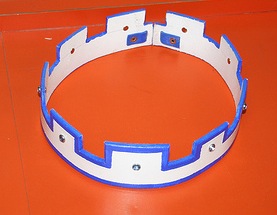Difference between revisions of "Crown"
(→Links) |
(→Links) |
||
| Line 44: | Line 44: | ||
*[[Knight of the Crown]] | *[[Knight of the Crown]] | ||
*[http://www.virtue.to/articles/circlet.html How to Circlet, 14th Century] | *[http://www.virtue.to/articles/circlet.html How to Circlet, 14th Century] | ||
| + | *[http://www.royalexhibitions.co.uk/Crown-Jewels/crowns.html British crown Jewels replicas] | ||
| + | *[http://www.organicarmor.com/Products/Armor/Circlets/Circlets.htm Buy funky Circlets] | ||
| + | *[http://www.brazinlady.com/2-circlets.htm Brass wire circlets] | ||
| + | *[http://www.shiningmoon.com/jewelry/crowns.html Silver Crowns] | ||
| + | *[http://www.camiasdesigns.com/pages/circlets/j-circlets.html Silver wire Circlets (girly)] | ||
| + | *[http://www.ingasbo.com/index.php Embossed band Circles, unisex] | ||
[[Category: Amtgard Things]] [[Category:Amtgard Terms]] | [[Category: Amtgard Things]] [[Category:Amtgard Terms]] | ||
Revision as of 03:20, 17 February 2009
Contents
Show your Fealty to the Crown!

Mundane definition
A crown is the traditional symbolic form of headgear worn by a monarch or by a deity, for whom the crown traditionally statue power, legitimacy, immortality, righteousness, victory, triumph, resurrection, honour and glory of life after death. In art the crown may be shown being offered to those on Earth by Angels. Apart from the traditional form, crowns also may be made of for example flowers, stars, oak leaves or thorns and be worn by others, representing what the coronation part aims to symbolize with the specific crown.
A coronet is a small crown consisting of ornaments fixed on a metal ring. Unlike a crown, a coronet never has arches. The word stems from the Old French coronete, a diminutive of co(u)ronne ("crown"), itself from the Latin corona (also "wreath").
Traditionally, such headgear is – as indicated by the German equivalent Adelskrone (literally "crown of nobility") – used by nobles and by princes and princesses in their coats of arms, rather than by monarchs, for whom the word crown is customarily reserved in formal English, while many languages have no such terminological distinction. Other than a crown, a coronet shows the rank of the respective noble. Hence, in German language there is also the term Rangkrone.
The Crown in Amtgard
1.Slang for the Monarchy usually of a kingdom.
2. The object it's self. A metal band or headdress used to signify station.
Crowning Traditions
Coronets
Lesser crowns or coronets are sometimes worn by Amtgarders usually at court or some official function. It is considered rude to wear a coronet if you are not a titled noble. It is also considered rude to wear a crown that is above your station or fancier than the Monarchs.
Examples of Crowns
- Lord; Typically a thin band of metal or leather, sometimes having a single point in the center front.
- Baronet; Some what larger than a lord's coronet, almost always having a single point in the front.
- Baron; traditionally bearing six points, as in heraldry.
- Count; Traditionally embattled, or topped with dags.
- Duke; Often has at least four points, and bears strawberry leaves.
- Archduke
- Grand Duke
Coronets in Heraldry and Britan

The main use is now actually not on the head (indeed, many people entitled to a coronet never have one made; the same even applies to some Monarchs' crowns, as in Belgium) but as a rank symbol in heraldry, adorning a coat of arms. In the United Kingdom, a peer wears his or her coronet on one occasion only: for a royal coronation, when it is worn along with coronation robes, equally standardized as a luxurious uniform. In the peerage of the United Kingdom, the design of a coronet shows the rank of its owner, as in German, French and various other heraldic traditions.
- The coronet of a duke (a silver-gilt circlet, chased as jewelled but not actually gemmed) has eight strawberry leaves of which five are seen in two-dimensional representations,
- that of a marquess has four strawberry leaves and four silver balls (known as "pearls", but not actually pearls), slightly raised on points above the rim, - of which three leaves and two balls are seen,
- that of an earl has eight strawberry leaves (four visible) and eight "pearls" raised on stalks, of which five are visible,
- that of a viscount has sixteen "pearls" touching one another, nine being seen in representation, and
- that of a baron (a plain silver-gilt circlet) has six "pearls" of which four are visible.
Since a person entitled to wear a coronet customarily displays it in their coat of arms above the shield and below the helm and crest, this can provide a useful clue as to the owner of a given coat of arms.